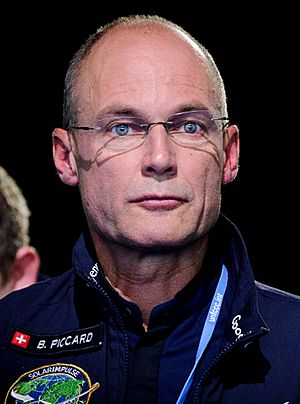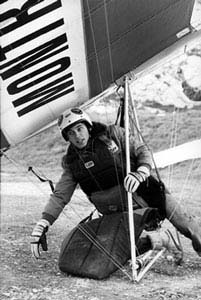Bertrand Piccard facts for kids
Quick facts for kids
Bertrand Piccard
|
|
|---|---|

Piccard in 2015
|
|
| Born | 1 March 1958 |
| Alma mater | University of Lausanne |
| Occupation | Psychiatrist and aviator |
| Organization | Solar Impulse |
| Known for | Ballooning, solar flight |
| Children | 3 |
| Parent(s) |
|
| Relatives | Auguste Piccard (grandfather) |
Bertrand Piccard (born March 1, 1958) is a famous Swiss explorer, doctor, and environmentalist. He is known for his amazing flights around the world.
With Brian Jones, he was the first person to fly a balloon non-stop around the entire globe. Their balloon was called Breitling Orbiter 3. Bertrand Piccard also started and piloted Solar Impulse. This was the first airplane to fly around the world using only power from the sun!
In 2012, the UN Environment Programme gave him a special award called "Champions of the Earth." He also started and leads the Solar Impulse Foundation.
Contents
Early Life and Learning
Bertrand Piccard was born in Lausanne, Switzerland. His family has a long history of exploring. His grandfather, Auguste Piccard, was a famous balloonist and explored deep under the sea. Bertrand's father, Jacques Piccard, also explored the ocean's depths.
When he was a child, Bertrand saw many space rocket launches. Even though he was scared of heights at first, he started hang gliding at age 16. He became very interested in flying and how people act in tough situations. He later studied at the University of Lausanne and became a psychiatrist, a type of doctor who helps people with their thoughts and feelings.
Amazing Flights and Career
Bertrand Piccard is now a teacher and supervisor for a Swiss medical group. He has licenses to fly many different types of aircraft. These include balloons, airplanes, gliders, and motorized gliders. In the 1970s, he was one of the first people to do hang gliding and microlight flying in Europe. In 1985, he even became the European champion for hang-glider aerobatics.
The Breitling Orbiter Balloon
On March 1, 1999, Bertrand Piccard and Brian Jones began an incredible journey. They took off in their balloon, Breitling Orbiter 3, from Château d'Oex in Switzerland. The balloon was bright red and shaped like an egg.
They completed the first non-stop balloon flight around the world! This flight did not use any fuel to move forward. Piccard and Jones worked with a team of weather experts on the ground. They used strong winds called jet streams to help them fly.
They traveled 25,361 miles (45,755 km) and landed in Egypt. The flight lasted 19 days, 21 hours, and 47 minutes. For this amazing achievement, Piccard received many awards. These included the Harmon Trophy and the FAI Gold Air Medal.
The Solar Impulse Project
In November 2003, Piccard announced a new project. He wanted to build a solar-powered airplane that could fly long distances. He worked with the École Polytechnique Fédérale de Lausanne (EPFL) on this project, which he named Solar Impulse.
Construction of the plane began in 2007. Piccard and André Borschberg did short test flights in 2009. By 2006, Piccard had gathered a team of 50 experts from six countries. About 100 other advisors also helped them. Many private companies and people in Europe helped pay for the project.
In 2010, the first Solar Impulse plane (Si1) made its first flight at night. In 2011, it landed in Paris. In 2012, it made its first flight between continents. It flew from Switzerland to Morocco in two parts. Borschberg flew the first part, and Piccard flew the second. In 2013, they flew across the United States. They started in California and ended in New York City, making several stops.
In 2015, the Solar Impulse team aimed to make history. They wanted to complete the first round-the-world solar flight. The journey started on March 9 and took about five months. They made stops in places like India, China, and the United States to switch pilots. On April 24, 2016, Piccard landed Solar Impulse 2 (Si2) in California. He had flown for three days from Hawaii.
André Borschberg and Piccard finished their flight around the world on July 26, 2016. On that same day, they announced a new group. It was called the World Alliance for Clean Technologies.
Working with the UN
In December 2015, while still flying around the world, Piccard became a Goodwill Ambassador for the United Nations Environment Programme. This means he helps promote the UN's environmental goals.
After finishing the flight, Piccard and the Solar Impulse Foundation started the non-profit World Alliance for Clean Technologies. This group works to find and promote clean technologies.
In 2018, Piccard shared that he had found over 500 ideas to help the environment. These ideas were also good for business. In May 2018, his Foundation launched the "Efficient Solutions Label." This label is given to solutions that are good for the environment and also make money. By 2021, the foundation had found and certified 1000 such solutions.
Hydrogen Car Record
In 2019, Piccard set a new record. He drove a hydrogen car farther than anyone else without refueling. He drove a Hyundai NEXO SUV for 778 kilometers (483.4 miles) in Europe. His goal was to show how useful hydrogen technology can be.
Solar Impulse Foundation
After his amazing solar flight around the world, Bertrand Piccard started the Solar Impulse Foundation. Its main goal is to find new and smart ways to solve environmental problems. The foundation wants to show these solutions to leaders. This will help speed up the move to a more sustainable economy.
To find these clean solutions, the Solar Impulse Foundation created the "Solar Impulse Efficient Solution Label" in May 2018. Experts carefully check each solution. They look at how good it is for the environment and if it can make money. This label is given to solutions that help achieve goals related to water, energy, and sustainable cities. In April 2021, Piccard and his foundation reached their goal of finding the first 1000 solutions.
Family History
Bertrand Piccard comes from a family of explorers. His grandfather, Auguste Piccard, was the first person to fly into the stratosphere in 1931. His father, Jacques Piccard, was the first to go to the very bottom of the Mariana Trench in 1960.
His great uncle, Jean Félix Piccard, and aunt, Jeannette Piccard, were also balloonists. Their son, Donald Piccard, was the first to fly a balloon across the English Channel. Bertrand once said that his family's motto is: if someone says something is impossible, that's exactly why they try to do it!
Awards and Honors
- Honorary Professor and Doctor of Science
- Mungo Park Medal (2018)
- Gold Medal of Youth and Sport
- Harmon Trophy
- Hubbard Medal (1999)
- Golden Plate Award of the American Academy of Achievement (1999)
- FAI Gold Air Medal
- Winner of the first trans-Atlantic balloon race (1992 Chrysler Challenge)
 Légion d'Honneur (Commander)
Légion d'Honneur (Commander) Officer of the Order of the Alawites
Officer of the Order of the Alawites- Médaille de l'aéronautique
See also
 In Spanish: Bertrand Piccard para niños
In Spanish: Bertrand Piccard para niños
- List of firsts in aviation
- List of circumnavigations


